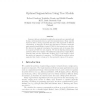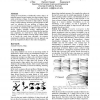ICDM
2006
IEEE
15 years 7 months ago
2006
IEEE
82
Voted
ICDM
2006
IEEE
15 years 7 months ago
2006
IEEE
Shape clustering can significantly facilitate the automatic labeling of objects present in image collections. For example, it could outline the existing groups of pathological ce...
ICDM
2006
IEEE
15 years 7 months ago
2006
IEEE
124
Voted
ICDM
2006
IEEE
15 years 7 months ago
2006
IEEE
In this paper, we propose a hybrid approach for automatic single-organ segmentation in Computed Tomography (CT) data. The approach consists of three stages: first, a probability i...
ICDM
2006
IEEE
15 years 7 months ago
2006
IEEE
In this paper, we investigate the use of data mining, in particular the text classification and co-training techniques, to identify more relevant passages based on a small set of...
79
Voted
ICDM
2006
IEEE
15 years 7 months ago
2006
IEEE
We address the problem of capturing and tracking local correlations among time evolving time series. Our approach is based on comparing the local auto-covariance matrices (via the...
98
Voted
ICDM
2006
IEEE
15 years 7 months ago
2006
IEEE
Sequence data are abundant in application areas such as computational biology, environmental sciences, and telecommunications. Many real-life sequences have a strong segmental str...
80
Voted
ICDM
2006
IEEE
15 years 7 months ago
2006
IEEE
We describe a large-scale application of methods for finding plagiarism and self-plagiarism in research document collections. The methods are applied to a collection of 284,834 d...
ICDM
2006
IEEE
15 years 7 months ago
2006
IEEE
Among the visual features of multimedia content, shape is of particular interest because humans can often recognize objects solely on the basis of shape. Over the past three decad...
100
Voted
ICDM
2006
IEEE
15 years 7 months ago
2006
IEEE
High dimensionality remains a significant challenge for document clustering. Recent approaches used frequent itemsets and closed frequent itemsets to reduce dimensionality, and to...




